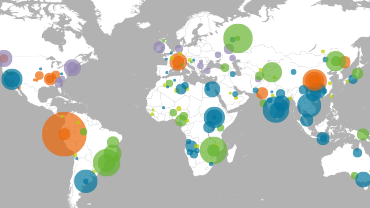Increase of reported diphtheria cases among migrants in Europe due to Corynebacterium diphtheriae, 2022
Diphtheria is an infectious bacterial disease, which can be prevented by vaccination. Transmission occurs via airborne respiratory droplets, direct contact with respiratory secretions, or direct contact with exudate from infected cutaneous lesions. Diphtheria can present with respiratory or cutaneous (skin) symptoms, and, in some cases can affect the heart, kidneys and the nervous system.
On 6 October 2022, ECDC published a Rapid Risk Assessment, ‘Increase of reported diphtheria cases among migrants in Europe due to Corynebacterium diphtheriae, 2022’. The conclusions and options for response suggested in this publication remain valid for the present event. Currently, an increased number of diphtheria cases among migrants is still being observed in the EU/EEA, and an unusually broad predicted resistance of Corynebacterium (C.) diphtheriae isolates to common oral and parenteral antibiotics has been reported.
Since the beginning of 2022, and as of 2 December 2022, 154 cases of diphtheria have been reported by eight EU/EEA countries: Germany (64), Austria (42), Belgium (18), France (14), Norway (7), the Netherlands (5), Italy (3), and Spain (1). Diphtheria cases linked to migrants have also been reported in Switzerland (25) and the United Kingdom (53), bringing the overall number for Europe to 232 cases. The majority of cases have been diagnosed among migrants residing in or exposed to reception centres for migrants. This is an increase of 140 cases since the publication of the Rapid Risk Assessment on 6 October 2022, when 92 cases of diphtheria among migrants were reported by seven European countries and one fatal case was identified. C. diphtheriae has been detected in all cases, and the majority of them have presented with the cutaneous form of the disease.
On 3 November 2022, a rapid communication published in Eurosurveillance reported two C. diphtheriae isolates in Switzerland possibly linked to the increase observed in the EU/EEA, and an unusually broad predicted resistance to common oral and parenteral antibiotics. According to the authors, these findings challenged the treatment options for bacterial co-infections in the wounds of the cases. On 17 November 2022, another rapid communication was published in Eurosurveillance, in which phenotypic and predicted resistance data from cases in Germany confirmed the predicted resistance profile observations from the two isolates in Switzerland. On 1 December 2022, the United Kingdom Health Security Agency (UKHSA) released a ‘Supplementary guidance for cases and outbreaks in asylum seeker accommodation settings’, in which antimicrobial susceptibility testing of all C. diphtheriae isolates is recommended.
The occurrence of isolates (in other European countries) showing a genomic profile suggestive of antimicrobial resistance similar to that observed in Switzerland and Germany cannot be ruled out. However, the above findings are preliminary and more evidence would be needed before assessing the potential implications of these observations, including the adaptation of the currently recommended antibiotic treatment regimes. In view of these ongoing developments, ECDC recommends, as a precautionary measure, that antimicrobial susceptibility testing is performed on all C. diphtheriae isolates.
As of 2 December 2022, ECDC has no data indicating further transmission and outbreaks of C. diphtheriae in the broader EU/EEA population resulting from the increased number of diphtheria cases observed.
ECDC is monitoring the ongoing situation together with the countries reporting cases, in the same way as the Centre handles other disease outbreaks. The Centre collects data through its surveillance and monitoring platforms: EpiPulse (the European surveillance portal for infectious diseases) and TESSy (The European Surveillance System). Additionally, the Epidemic Intelligence 24/7 duty system at ECDC allows a timely and constant event-based surveillance of the present situation. This system complements the two surveillance and monitoring platforms, and promptly provides relevant epidemiological updates. Whole-genome sequencing services can also be provided by ECDC for full genomic analysis of additional cases.






